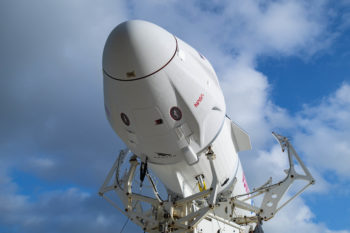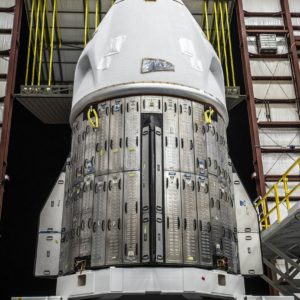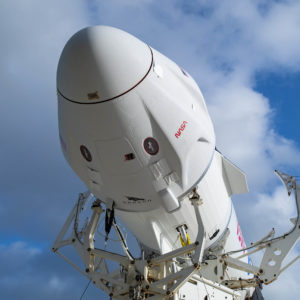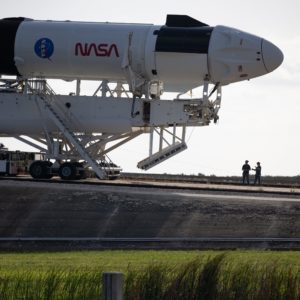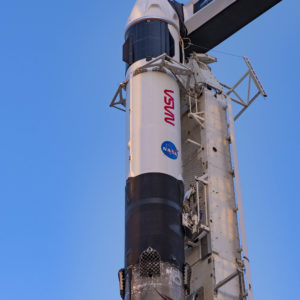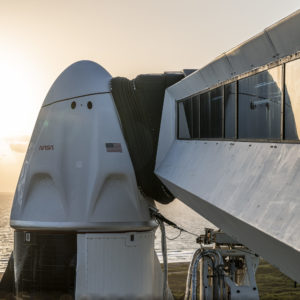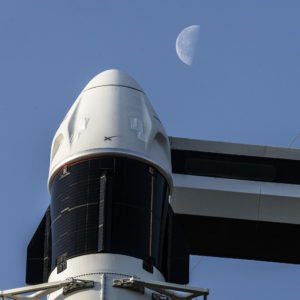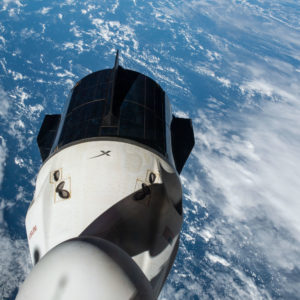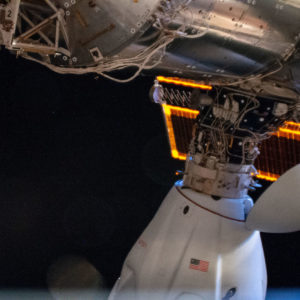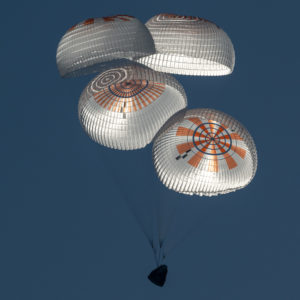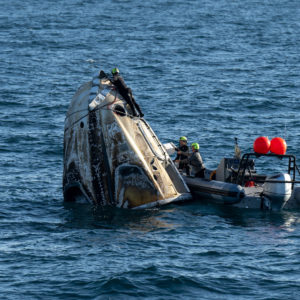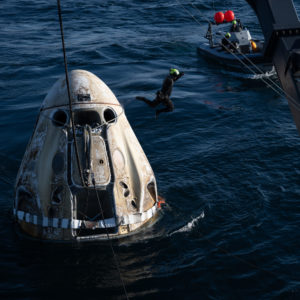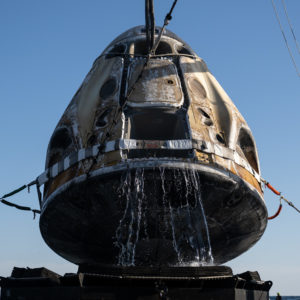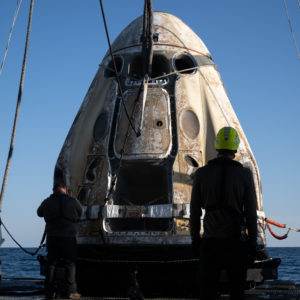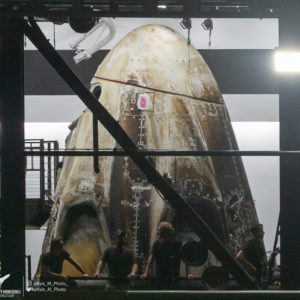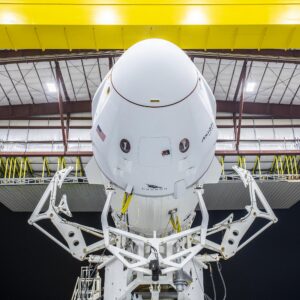List of Dragon Capsules
| Crew Dragon | Cargo Dragon 2 | Dragon 1 | Other |
This is a list of all produced Dragon 1 and Dragon 2 capsules and key information about them. The list will be updated over time.
Note: Dragon 1 versioning system is unofficial and might not be correct.
Changelog:
- Apr 5, 2025 – Capsule C207.4 successfully completed the Fram2 mission; capsule C206.6 will be used on Crew-11
- Mar 14, 2025 – Capsule C210.4 launched on Crew-10; new capsule C213 will launch on Ax-4
- Nov 5, 2024 – Fram2 will use capsule C207.4; capsule C208.5 successfully launched on CRS-31
- Oct 26, 2024 – Updated profile and photos of capsule C206 after the conclusion of the Crew-8 mission
- Sep 29, 2024 – Capsule C212.4 launched on Crew-9
Crew Dragon Capsules:
Capsule C213
- Plan: Will launch on Ax-4 in 2025
- Notes:
- This should be the last newly-built Crew Dragon capsule
- Originally intended to launch first on Crew-10 but was reassigned to Ax-4 due to manufacturing delays
Capsule C212 “Freedom”
- Missions:
- Total time spent in space: 198 days (up until Ax-3 splashdown)
- Plan: Will probably be reused after Crew-9
- Notes:
- This was at one point set to be the last newly-built Crew Dragon capsule, but then SpaceX decided to make one more
- Crew-4 astronauts named the capsule “Freedom”
- Capsule has reused the heatshield structure, but not the TPS (Crew-4)
- One of the upgrades in this capsule are new USB ports for astronauts to charge their devices
Capsule C210 “Endurance”
- Missions:
- Total time spent in space: 533 days (up until Crew-7 return)
- Plan: Capsule will likely be used again
- Notes:
- For the first time, the ship was launched with a reused nose cone (Crew-3)
- This Dragon has several improvements over the previous ones. Issue with the toilet has been fixed, stitching on drogue chutes’ riser sleeve has been improved and there are other improvements for docking procedures, computer performance during reentry and more.
- Crew-5 was the first crewed mission with reused internal window panes and all four bulkhead Draco thrusters being reused.
Capsule C207 “Resilience”
- Missions:
- Crew-1 (launched on November 16, 2020, returned on May 2, 2021)
- Inspiration4 (launched on September 16, 2021, returned on September 18, 2021)
- Polaris Dawn (launched on September 10, 2024, returned on September 15, 2024)
- Fram2 (launched on April 1, 2025, returned on April 4, 2025)
- Total time spent in space: 178 days
- Plan: Will probably be reused
- Notes:
- The capsule was used on the first post-certification mission called Crew-1
- The capsule has some upgrades compared to C206. For example, it has stronger outer panels that allow it to land in harsher winds, and it was the first Dragon able to dock at the other ISS port with IDA-3 (Node 2 zenith). SpaceX also made some improvements to the heatshield based on findings from the DM-2 mission.
- The Crew-1 astronauts decided to name the capsule Resilience prior to its first launch
- The capsule was reused on a historically first fully commercial tourist mission Inspiration4
- For the Inspiration4 mission, the capsule was equipped with a glass cupola to provide better views of Earth while in orbit. The cupola replaced the docking mechanism which isn’t needed for missions that don’t go to ISS.
- For the Polaris Dawn mission, the capsule was equipped with a device called Skywalker which replaced the docking port and provided handholds and support during that mission’s EVA.
- This Dragon will get the cupola from Inspiration4 for the Fram2 mission.
Capsule C206 “Endeavour”
- Missions:
- DM-2 (launched on May 30, 2020, returned on August 2, 2020)
- Crew-2 (launched on April 24, 2021, returned on November 9, 2021)
- Ax-1 (launched on April 8, 2022, returned on April 25, 2022)
- Crew-6 (launched on March 2, 2023, returned on September 4, 2023)
- Crew-8 (launched on March 4, 2024, returned on October 25, 2024)
- Total time spent in space: 702 days
- Plan: Will be reused on Crew-11 in 2025
- Notes:
- The capsule was intended for the first post-certification mission but was reassigned to DM-2 after the C201 anomaly in April 2019
- Since this capsule was originally meant to fly on the first post-certification mission, it is technically capable of supporting a long-duration stay on the ISS, if needed
- SpaceX President Gwynne Shotwell said that this capsule will be shipped from Hawthorne by the end of December 2019 to be tested in a vacuum chamber
- The capsule has undergone electromagnetic testic in early 2020 (video)
- Capsule was transported from Hawthorne to Florida in February 2020 and after being mated to the trunk it was moved to LC-39A’s HIF on May 15, 2020 (video)
- First Dragon to carry astronauts to orbit
- DM-2 crew decided to name the capsule Endeavour after they reached orbit
- First Crew Dragon to be reused (Crew-2)
- First Crew Dragon to be reused two times (Ax-1)
- First Crew Dragon to be reused three times (Crew-6)
- First Crew Dragon to be reused four times (Crew-8)
Capsule C205
- Missions: Crew Dragon In-Flight Abort Test (January 19, 2020)
- Total time spent in space: 0 days (the first and only launch was suborbital)
- Plan: Probably retired
- Notes:
- According to NASA, the capsule was originally scheduled to be fully integrated in March 2019
- The capsule was intended for the first crewed demonstration mission (DM-2) but was reassigned to the in-flight abort test after the C201 explosion in April 2019
- The capsule arrived to Cape Canaveral in early October 2019 and on November 13 underwent a successful static firing
- The capsule had a stripped-down interior since many of the systems weren’t needed for the abort test
- The capsule might be reused in the future but Elon Musk said it was unlikely
Capsule C201
- Missions: DM-1 (launched on March 2, 2019, returned March 8, 2019)
- Total time spent in space: 6 days
- Plan: Capsule was destroyed during an engine test
- Notes:
- This capsule was tested in an anechoic chamber in May 2018, then underwent vacuum testing in Ohio in July after which it was shipped to Cape Canaveral
- In March 2019, the capsule successfully flew on the first demonstration mission without crew. It spent 5 days on the ISS and then successfully landed in the Atlantic.
- This capsule was supposed to be reused on the in-flight abort test, but on April 20, 2019, it suffered an anomaly during a thruster test and was destroyed
Cargo Dragon 2 Capsules:
Capsule C211
- Missions:
- Total time spent in space: 46 days (until the return from CRS-26)
- Plan: Will probably launch again after CRS-29
- Notes:
- The third Cargo Dragon 2 to be produced
- This might be the final Cargo Dragon to be manufactured, according to SpaceX. But the production line can be restarted in the future if needed.
Capsule C209
- Missions:
- Plan: Will probably be reused
- Notes:
- The second Cargo Dragon 2 to be produced
- The serial number has not been officially confirmed yet
- The capsule flew on CRS-22 with a heatshield from DM-2. It was the first time a Dragon heatshield was reused.
Capsule C208
- Missions:
- Total time spent in space: 133 days (until the return from CRS-28)
- Plan: Will probably launch again after CRS-31
- Notes:
- The first Cargo Dragon 2 to be produced
- The capsule design is very similar to Crew Dragon but there are some difference, the main one is the lack of SuperDraco thrusters.
- Compared to the original Cargo Dragon, the main difference is that the Crago Dragon 2 automatically docks to the ISS, while the old Dragon had to be manually berthed by the station’s robotic arm. Docking also means that the hatch opening is smaller on Cargo Dragon 2, so it cannot transport larger cargo items, because it wouldn’t fit through the opening.
- The first Cargo Dragon 2 to be reused (on CRS-23).
- The first Cargo Dragon 2 to launch three times (on CRS-25).
- The first Cargo Dragon 2 to launch four times (on CRS-28).
Dragon 1 Capsules:
Capsule C113
- Version: v1.2
- Missions:
- Total time spent in space: 64 days
- Plan: This capsule was put on permanent in display at the Museum of Science and Industry in Chicago, IL
- Notes:
- 13th Dragon 1 capsule produced
- Last newly manufactured Dragon 1 capsule
- 6th reused Dragon 1
Capsule C112
- Version: v1.2
- Missions:
- Total time spent in space: 99 days
- Plan: Won’t fly again
- Notes:
- 12th Dragon 1 capsule produced
- 5th reused Dragon 1
- 3rd Dragon 1 to be used three times
- Last Dragon to fly
Capsule C111
- Version: v1.2
- Missions:
- Total time spent in space: 74 days
- Plan: Won’t fly again
- Notes:
- 11th Dragon 1 capsule produced
- 4th reused Dragon 1
- During CRS-15, this capsule became the 30th spacecraft that was berthed to the ISS using the Canadarm2
- During CRS-15 landing, this capsule encountered a parachute anomaly which resulted in higher-than-expected loads
Capsule C110
- Version: v1.2
- Missions:
- Total time spent in space: 66 days
- Plan: Won’t fly again
- Notes:
- 10th Dragon 1 capsule produced
- 3rd reused Dragon 1
- First capsule to have enhanced water sealing capability
Capsule C109
- Version: v1.1
- Missions: CRS-7 (June 28, 2015)
- Total time spent in space: 0 days (the first and only launch didn’t reach orbit)
- Plan: Capsule was destroyed during the CRS-7 mission
- Notes:
- 9th Dragon 1 capsule produced
- The capsule was destroyed as a result of a second stage anomaly during the CRS-7 launch
- The capsule initially survived the disintegrating rocket but the control software was not designed for this eventuality so the parachutes couldn’t be opened and the capsule was destroyed after impacting the ocean. All future Dragons have their software updated to be able to open parachutes in a similar scenario.
Capsule C108
- Version: v1.1
- Missions:
- Total time spent in space: 98 days
- Plan: Won’t fly again
- Notes:
- 8th Dragon 1 capsule produced
- 2nd reused Dragon 1
- 1st Dragon that was used three times
Capsule C107
- Version: v1.1
- Missions: CRS-5 (launched on January 10, 2015, returned on February 11, 2015)
- Total time spent in space: 32 days
- Plan: Won’t fly again
- Notes:
- 7th Dragon 1 capsule produced
- For an unknown reason, this capsule hasn’t been reused
Capsule C106
- Version: v1.1
- Missions:
- Total time spent in space: 97 days
- Plan: Won’t fly again
- Notes:
- 6th Dragon 1 capsule produced
- 1st reused Dragon 1
- 2nd Dragon that was reused three times
Capsule C105
- Version: v1.1
- Missions: CRS-3 (launched on April 18, 2014, returned on May 18, 2014)
- Total time spent in space: 30 days
- Plan: Won’t fly again
- Notes:
- 5th Dragon 1 capsule produced
- First capsule to receive a set of major upgrades, unofficially called Dragon v1.1
Capsule C104
- Version: v1.0
- Missions: CRS-2 (launched on March 1, 2013, returned on March 26, 2013)
- Total time spent in space: 25 days
- Plan: Won’t fly again
- Notes:
- 4th Dragon 1 capsule produced
- Shortly after separating from the second stage, there was an issue with 3 of the 4 Draco thruster pods (the vehicle detected insufficient pressurization on the oxidizer system). This led to solar arrays not deploying. Eventually, the arrays were deployed remotely and SpaceX managed to regain control of all 4 thruster pods.
- First time the capsule’s trunk was used to transport cargo to the ISS
- Last launch on Falcon 9 v1.0
Capsule C103
- Version: v1.0
- Missions: CRS-1 (launched on October 8, 2012, returned on October 28, 2012)
- Total time spent in space: 20 days
- Plan: Won’t fly again
- Notes:
- 3rd Dragon 1 capsule produced
- First operational mission under the CRS contract for NASA
Capsule C102
- Version: v1.0
- Missions: COTS-2 (launched on May 22, 2012, returned on May 31, 2012)
- Total time spent in space: 9 days
- Plan: This capsule is displayed in Kennedy Space Center
- Notes:
- 2nd Dragon 1 capsule produced
- First private spacecraft to berth with the ISS
- First capsule with solar arrays
Capsule C101
- Version: v1.0
- Missions: COTS-1 (launched and returned on December 8, 2010)
- Total time spent in space: <1 day
- Plan: This capsule is displayed in the SpaceX factory in Hawthorne, CA
- Notes:
- 1st Dragon 1 capsule produced
- First private spacecraft that orbited the Earth and then was successfully recovered
- The capsule carried a wheel of cheese as a reference to Monty Python’s Cheese Shop Sketch. This was revealed to the public only after Dragon successfully returned from space.
- The capsule was deployed without its trunk and therefore didn’t utilize solar arrays
- This capsule orbited the Earth twice before returning
Other
Structural Test Article
- Missions: None
- Plan: Unlikely to be used again
- Notes:
- Dragon 2 pressure vessel that was used for structural testing
- Testing took place in McGregor, Texas, in 2016
- It is assumed this capsule has serial number C202
ECLSS Test Module
- Missions: None
- Plan: Unknown
- Notes:
- This pressure vessel was used in March 2017 for Crew Dragon’s ECLSS testing (Environmental Control and Life Support System)
- The vessel had a transparent floor so that the engineers could better see how the various systems were working
DragonFly
- Missions: Pad Abort Test (May 6, 2015) – video #1, video #2
- Plan: Retired
- Notes:
- This capsule was dubbed DragonFly and was a Dragon1/Dragon 2 hybrid – it was a modified Dragon 1 pressure vessel equipped with SuperDraco thrusters
- Apart from the pad abort test, DragonFly was also used for hover tests in McGregor
- The testing in McGregor was supposed to last about two years but ended after less than 6 months (probably because SpaceX cancelled Red Dragon and moved away from Dragon 2 landing propulsively)
- After retiring, DragonFly was sometimes displayed publicly at various SpaceX events
Dragon Spacecraft Qualification Unit
- Missions: Falcon 9 Demo (June 4, 2010)
- Plan: Capsule was destroyed as planned after reentering the atmosphere
- Notes:
- This was a boilerplate unit used during the Falcon 9 demo mission
- It wasn’t designed to separate from the second stage
- The second stage with the DSQU still attached disintegrated in the atmosphere on June 27, 2010
DragonLab Qualification Unit
- Missions: None
- Notes:
- A picture of a DragonLab Qualification Unit was shared by SpaceX in 2008 as part of an announcement of two DragonLab missions. Nothing more is known about this particular pressure vessel.
- DragonLab was supposed to be a free-flying, reusable spacecraft capable of hosting pressurized and unpressurized payloads to and from space but it never flew and has likely been cancelled
- From SpaceX’s 2008 press release: “DragonLab provides a platform for in-space experimentation, including recovery of pressurized and some unpressurized payloads, as well as deployment of small spacecraft. As a complete system, DragonLab provides for all aspects of operation: propulsion, power, thermal control, environmental control, avionics, communications, thermal protection, flight software, guidance, navigation and control, entry, descent and landing and recovery.”
Most of the information on this page was sourced from the Capsule History article on the r/spacex wiki. The majority of photos on this list was taken from this NASA Flickr album.



